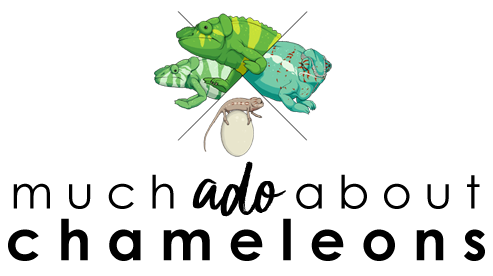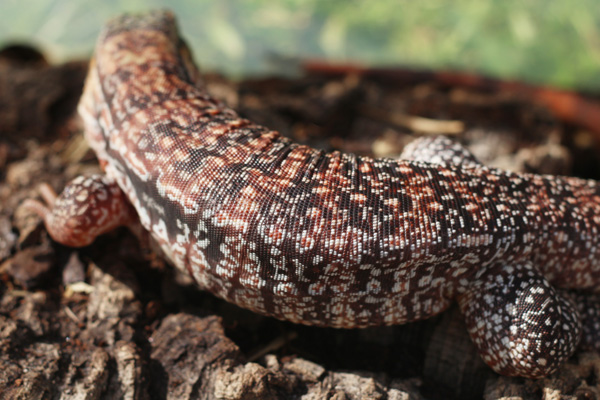The wise often advise to start keeping chameleons with males, and this is typically sound advice. This is because it is more prudent for an individual with no chameleon experience to begin with a male, who is not capable of laying clutches of eggs with or without contact with a male, and the health issues related with egg-laying. By raising a male chameleon first, adjusting how husbandry is handled for a female will be easier.
However, new keepers come in varying degrees of confidence so while the care of a female may scare one person, another may feel very capable of starting with a female. With enough research I think anyone can be very capable of starting with whichever they choose. Below I will outline the main differences between the sexes, using the common panther chameleon (F. pardalis) as an example.
However, in summary, either a male or female will make a beautiful, interesting, and fulfilling pet for anyone dedicated enough to keep these reptiles. Whichever you get depends on which gender meets your preferences better.
To learn how to sex panther chameleons, read
COLOR
 |
| An Ambilobe panther chameleon at 5 months old. |
 |
| The SAME Ambilobe just 6 months later. Big difference! |
However, females are not drab and ugly (at least not to everyone.) Females are not as flashy as males, this is true, but they can show very pretty pastel shades of pink or peach with varying degrees of rusty orange, purple, blue, or green. When receptive to mating they will get a solid, very vibrant pink-peach color, and when they are gravid with a clutch they will get an intense orange with black bars. So they are not ugly, but they simply show a different palette of colors. I almost think of them like mood stones, that change dramatically depending on where they are in their reproductive cycle, which is fun as a pet owner. I will have photos throughout this blog showing panthers of different types, so the differences in color between males and females will become very apparent.
SIZE
 |
| Female panther chameleon, in receptive peach colors. |
PERSONALITY
This is another big factor that people consider when looking to get a pet. There are rumors that say that female chameleons are more docile, and therefore make more friendly pets. This may be true to an extent, but it is not a rule. Since females do not have to defend a territory and fight off males, they may not be as defensive and loaded with angry testosterone like males are. But since personality is unique to every individual, you can still get very aggressive females. I've been lucky that mine is very sweet, just like my current male, but I have friends that have very angry females that they cannot hold without being bitten. So I cannot guess what the personality of any given chameleon will be like.
I have a separate blog in which I outlined how I deal with my chameleons in hopes of making them friendly. This may not work for all chameleons, but it cannot hurt if done with patience:
EGG-LAYING
 |
| A gravid female panther. Notice bight orange and black coloration. |
Only females lay eggs and this is the trickiest part of owning a female. Females are capable of laying eggs periodically without the presence of a male, and will lay these infertile clutches from as young as 6 months old and will continue to do so throughout their lives every few months. Because things can go wrong, this usually makes new keepers nervous. However, by providing a female with a suitable place to lay eggs many of these issues will be automatically avoided. Most people that lose their females to issues like egg-binding (a condition where the eggs fuse together and can no longer pass through the female) because they did not provide an adequate container of moist sand or soil to lay in, so the female just held in the eggs until they were too big to pass. Additionally, by keeping females slightly cooler (80-82°F) than males and by keeping them on a strict diet their metabolisms will slow to where they can either not lay clutches at all or lay significantly fewer eggs in each clutch. Both of which will help females live longer lives.
 |
| A 1.5 year old male Nosy Be panther chameleon |
LIFE SPAN
Because of the toll egg-laying takes on a female, females tend to live about half as long as males. This is an average of 2-3 years, where male panthers can live an average of 4-5, with some known to make it to 8. If husbandry is adjusted to help females lay fewer eggs throughout their lives females have also been known to live between 5-7 years. So unless you want to use them only for breeding, adhering to these techniques can add quite a bit of time to their lives.*Note: Here is an additional blog that goes into the specific care of females that can help them not lay clutches or lay fewer eggs per clutch. This includes adhering to a strict diet and lowering her basking temperature to slow down her metabolism and reproductive cycle: On The Specific Care of Females
ADDITIONAL PHOTOS
Below are additional photos of a single panther female showing the wide variety of colors and patterns she shows depending on her mood, followed by a few more male panthers.
 |
| Here she is in a different, non-receptive mood. For a week she had hundreds of purple dots all over, with a pink base. |














Dear Olimpia,
ReplyDeleteYour blog is amazing! I wish I had a pet Cham too :(
Thank you so much!
DeleteThank you 4 the info :)
ReplyDeleteI absolutely love your blog and it has become my point of reference for anything chameleon related! I have a question, we have a beautiful female panther, is there anyway of telling if she is a blue or red bar ambilobe?
ReplyDeleteThank you! No, unfortunately, with females it's essentially impossible to know what locale they are, much less what variety they are.
DeleteI think I quite like the mystery!
DeleteJust bought a male and a female chameleon for my children. I am grateful for all the info as I believe the pet-store was very either mis-informed or they outright lied to make the sales. Thanks for the true info!
DeleteHi, female has laid eggs but something about her front leg doesn't look right, it looks like it's dislocated and she is just lieing down with her back leg tightly gripped on her front leg. What should I do? She's not eating either.
ReplyDeleteThis is most likely a sign of metabolic bone disease (MBD). How long ago did she lay eggs? Make sure you supplement with a lot of calcium if its still an issue. I think its a broken bone :(
DeleteOlimpia, could you please help me sex my new cham.They told me at the store that it was a male but they also have no idea what type of cham he or she is so I'm aliitle leary of there qualifications. I really want a male since I'm a new owner. Thank you in advance.
ReplyDeleteOlimpia, could you please help me sex my new cham.They told me at the store that it was a male but they also have no idea what type of cham he or she is so I'm aliitle leary of there qualifications. I really want a male since I'm a new owner. Thank you in advance.
ReplyDeleteI am about to purchase a female chameleon for 200$. The place of purchase allows you to buy lifetime guarantee where you pay 8$ a month and at any point in time if/when your chameleon dies, they replace it. Do you think something like that is worth it?
ReplyDeleteThis will be my first chameleon.
DeleteHey Courtanee,
DeleteCongrats on your new cham! Is this going to be a panther chameleon? How old is she? If a panther female is worth $200 then at $8 a month you pretty much pay for a new one in 2 years. If this is from a pet store, I might probably do a few months of this insurance (say, 3-6 months?) which is the time window in which I think pet store chameleons are most likely to die from the poor care they tend to get. If she's doing really well in your care after that then I might not continue, but that is up to you. If she lives to be 4 years old you've ended up paying $768 for that new, second chameleon. So long term I think it's probably necessary, but in the short term it's a good idea, just in case. The older they are the more stable they are too, so once she's out of that baby size she should be fine with proper care.
Hey Courtanee,
DeleteCongrats on your new cham! Is this going to be a panther chameleon? How old is she? If a panther female is worth $200 then at $8 a month you pretty much pay for a new one in 2 years. If this is from a pet store, I might probably do a few months of this insurance (say, 3-6 months?) which is the time window in which I think pet store chameleons are most likely to die from the poor care they tend to get. If she's doing really well in your care after that then I might not continue, but that is up to you. If she lives to be 4 years old you've ended up paying $768 for that new, second chameleon. So long term I think it's probably necessary, but in the short term it's a good idea, just in case. The older they are the more stable they are too, so once she's out of that baby size she should be fine with proper care.
Not a pet owner - just wandering your interesting site. I appreciate people who care for animals for their own sake, not to profit from them.
DeleteRe: Comment above, $8/month x 4 years (48 months) is $384. Did you accidentally double the tally, or am I missing something?
Robin Drake
Freelance editor/writer
Oops, I think I must have! Not sure how I ended up with that math, now that you point it out.
DeleteThanks for the kind words and the correction!
You are very welcome for my minor assistance! Thank *you* for your concern for both these brilliant creatures and the even more colorful characters who choose them as companions. I believe the world is a more interesting place with all of them in it. :)
DeleteRobin Drake
Freelance editor/writer
Shes from a breeder not a pet store and yes it is a panther. Thanks for your reply! I think ill pay for 3 months of insurance just since its my first one and then discontinue after that. Thank you for the advice!
ReplyDeleteOops, I see I misspoke in my first reply, I meant to say "So long term I think it's probably *UNnecessary" but I think you understood me.
DeleteThat sounds sensible. Congrats again on the new chameleon!
Hi I've got a female veiled chameleon and she is approximately 1.5 year old, I've had her since she was around 3 months old and I have been reading up that they normally lay eggs at 4/5 months old, she has never layed eggs once in the year and 3 months I've had her, is it normal for her not to lay eggs or is it something i should worry about?
ReplyDeleteThat's curious! I would need to know more before I can really say anything (you can email me photos and info if you want to) but some people have kept veiled females from ever laying eggs thanks to keeping them a little cooler and limiting their food intake. So if you've been inadvertently doing this then that's fine, she will live longer for it. However, if maybe she has some vitamin deficiencies or something that could also be a reason. Without knowing more info I can't make any type of call.
DeleteHello ! You're information has been so helpful but I still have little questions. I have recently gotten my first chameleon, a veiled. I was unsure at first but after research I am am almost positive it is a female. I do not know how old she is, but I believe she's young, because she's rather small. I have all the proper food, cage and plant setups and all the environmental needs. She is still new to the place and has been timid. I have hand fed her once and all other times she's been afraid, which is expected because she's new and not use to me I suspect. I've read about females laying eggs and this is where I have questions. The cage I have is about 2.5 feet wide and 3 feet tall. Do I need a laying bin in the cage? How do I know when she is going to need to lay eggs, because I am not even sure how old she is? I've read as much as I can and I'm still just unsure about the egg laying needs and such.
ReplyDeleteThank you !!
Hi, sorry for the delay in replying. For a first-time owner I would recommend keeping a small laying bin in the cage at all times. If you see her digging around in there or in her plant pots, replace it for the full-sized laying bin. But the first time a female needs to lay can be tricky for a new keeper to spot, so I like having a decoy bin in the cage that serves as a sign to the owner.
Deletethat's exactly what ive done. thanks c:
Deleteis a female more agresive than a male
ReplyDelete